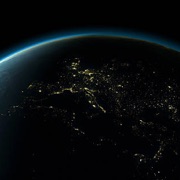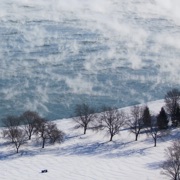AccuWeather meteorologists are available 24/7 to provide further insights and updates on evolving weather conditions. Please contact pr@accuweather.com during regular business hours, or support@accuweather.com or call AccuWeather’s Media Hotline at (814)-235-8710 at any time to arrange interviews with AccuWeather experts or to request the most updated graphics for print or broadcast.
AccuWeather 2024 U.S. Wildfire Forecast: Smoky Skies, Dangerous Air Quality To Return To America This Wildfire Season
|
|||||||||||
April 24, 2024
- Fewer wildfires to burn across America this year as compared to last year and the historical average.
-
- Near or above historical average number of wildfires in Canada this season, with U.S. smoke conditions possible again this year.
-
- The switch from an El Niño pattern this past winter to a La Niña pattern by late summer will have indirect impacts on the wildfire season in California.
- Texas Panhandle, the Oklahoma Panhandle, and parts of New Mexico, Michigan, Minnesota, and Wisconsin face the highest risk of significant wildfires this year.
AccuWeather Global Weather Center – April 24, 2024
AccuWeather expert long-range forecasters say smoke from fires that spark in Canada could have major impacts on air quality in the northern United States once again this year, according to AccuWeather’s 2024 U.S. Wildfire Forecast.
Although AccuWeather’s team is forecasting fewer wildfires to burn across America this year as compared to last year and the historical average, fires that spark in the U.S. could lead to evacuations and hazardous smoke this season.
AccuWeather’s 2024 U.S. Wildfire Forecast predicts 35,000 to 50,000 wildfires in America this year, burning 4 million to 6 million acres. AccuWeather’s forecast falls below the historical average of 68,707 wildfires and 7 million acres of land that burn in the U.S. annually.
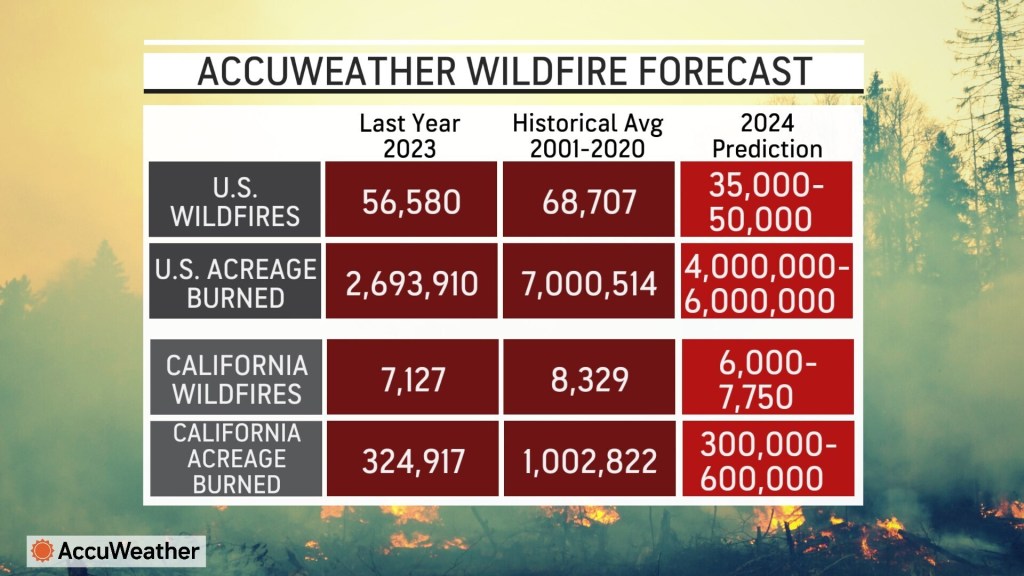
Records from the National Interagency Fire Center (NIFC) show that nearly 2.7 million acres of land burned in wildfires across the United States last year, the least amount of land to burn since 1998.
NIFC records say more than 7 million acres of land burned in the United States in both 2022 and 2021. A staggering 10.1 million acres of land were left scorched after the 2020 wildfire season in the U.S.
“As of early April, 1.8 million acres has burned already. That’s way ahead of last year’s pace. Most of that is because of the Smokehouse Creek Fire in Texas and Oklahoma,” said AccuWeather Lead Long-Range Forecaster Paul Pastelok. “Even though that puts us at a high rate now, we’re still forecasting a below-historical average number of fires and acres to burn this year. The drought coverage is below-historical average across the United States, especially when compared to recent years.”
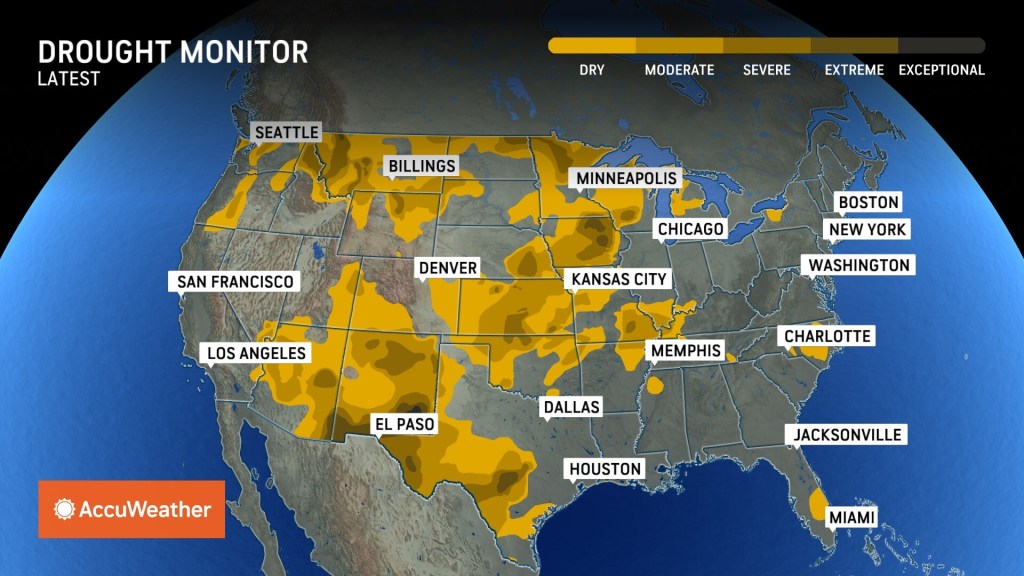
Wildfires in Canada shattered records last year with a staggering 45.7 million acres of land burned. Pastelok does not expect as many fires to burn in Canada this year, but says forecasters expect a near to above historical average number of fires in Canada in 2024. A lackluster snowpack across much of the Canadian Rockies to eastern Canada will lead to drier soil and dried-out vegetation, which acts as fuel for wildfires.
Because of the increased risk of fires in Canada, Pastelok warns that wildfire smoke from the north could once again lead to hazy skies and hazardous air quality for millions of Americans in northern and eastern states this summer.
Weather Patterns That Could Contribute To Wildfires In The U.S
The first areas of concern in the United States this spring and early summer are in the High Plains, the Midwest, and the western Great Lakes region.
Dry and windy periods in areas facing drought can create favorable conditions for fires to spark easily and spread quickly.

“As we get into the mid to late summer, the north-central Plains and the interior Northwest have the best chance to get some trigger mechanisms for dry thunderstorms,” said Pastelok.
Rounds of rain in the Northwest in June could prevent prescribed burns in the region, which are done to remove fuels and reduce the risk of large fires burning out of control.
The southwest U.S. monsoon typically starts in late June to mid-July. Pastelok says the monsoon is expected to start a bit later this year, and precipitation is forecast to be near or below the historical average.
“The longer the dry season lasts in the Southwest, the longer any fires that are burning can continue to burn,” explained Pastelok. “We may have an extended fire season in the Southwest which could allow for some bigger fires across that area.”
The switch from an El Niño pattern this past winter to a La Niña pattern by late summer will have indirect impacts on the wildfire season in California.
“La Niña cuts down the amount of tropical activity that can take place in the eastern Pacific on a normal basis,” said Pastelok. “If you look at last year, we had Hilary come up in August and provide a lot of moisture into California, cutting into the dry season. There may be less of a chance for that to happen, so the dry season is often extended during a La Niña.”
AccuWeather’s team of long-range forecasters announced in March that California is expected to be free of widespread drought through the end of 2025, following a second winter of back-to-back storms and above-historical average mountain snowpack.
“It’s still pretty moist, there’s not much drought. It may just get abnormally dry later in the season. That can prevent a lot of bigger fires and more acreage being burned this year,” explained Pastelok. “We have a lot of vegetation growth, that’s the risk. If a fire gets started and you can’t get to it in time, if it’s in a remote area, then we could have a couple of big fires to contend with.”
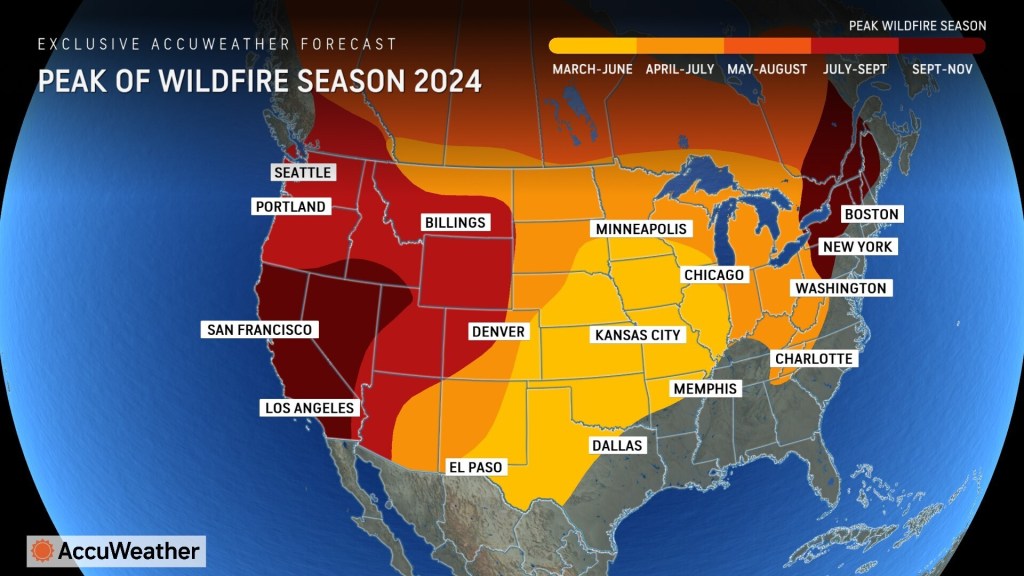
Patelok says wind is the driving force behind many big fires in California.
“Santa Ana winds are a big component. We have a setup where we could get high-pressure areas building across the Great Basin area in the fall season, but the jet stream is pretty far north,” explained Pastelok. “Those high-pressure areas may settle in pretty far north. That could cut down on Santa Ana wind events that take place this fall.”
Vegetation like shrubs and fallen pine needles will dry out by early summer in many areas of California. Pastelok said the mountain snowpack started to melt earlier this year, compared to last year, and the soil could dry out in spots earlier this summer.
"If extended streaks of heat and dryness occur in May and June, the risk of wildfires can start earlier during the summer, increasing rapidly into the fall for more significant fires," said Pastelok. "The combination of 2023 and 2024 wet seasons will contribute to extensive growth of new fuels."
Risk Of Significant Wildfires
The first significant wildfire of the year scorched more than 1 million acres of land in Texas and Oklahoma. Officials say a downed power line sparked the Smokehouse Creek Fire in late February.
Pastelok says the Texas Panhandle, the Oklahoma Panhandle, and parts of New Mexico, Michigan, Minnesota, and Wisconsin face the highest risk of significant wildfires this year.
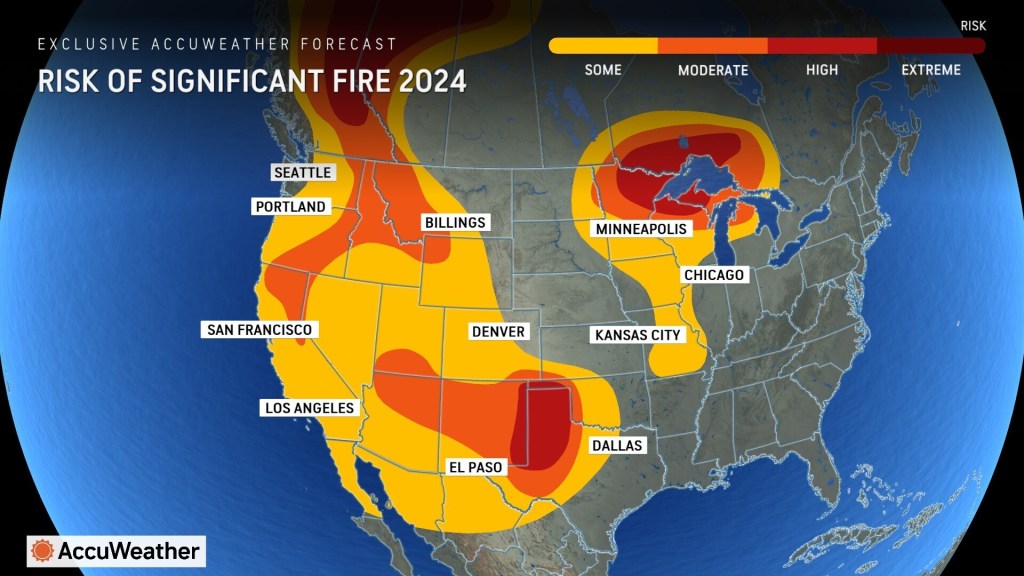
"The risk for wildfires could increase quickly across the Upper Midwest in the second half of spring because of the record-breaking warmth and dryness across the region this past winter," Pastelok explained.
AccuWeather expert meteorologists say the record-breaking warm temperatures, and lack of snow and ice this past winter caused an economic impact in the northern Plains and upper Midwest estimated at $8 billion in economic losses.
Some precipitation in the Midwest and Great Lakes could briefly reduce the fire threat during the spring months, but the risk will increase as summer arrives and temperatures heat up.
There is a particularly elevated fire risk in that area in June and July due to the threat of thunderstorms. Pastelok says lightning could potentially spark fires.
Hazardous Smoke and Dangerous Air Quality
AccuWeather long-range forecasters and air quality experts say people who work and live in areas that were impacted by smoky skies last summer could deal with rounds of poor air quality from wildfires burning in Canada again this year.
The worst air quality levels in New York City in the past 20 years were reported last June when smoke from wildfires burning in Canada poured into the region.
Plume Labs Air Quality Scientist Dr. Boris Quennehen said people breathing in the smoke-filled air in New York City were exposed to the same hazards as smoking five-to-10 cigarettes a day.
“Depending on the weather conditions, smoke from wildfires can be transported over very large distances, at different directions, and at different altitudes,” said Quennehen. “Denver was impacted by smoke from the Canadian wildfires last year. Two weeks later, that smoke had reached the Northeast. Smoke is made up of gases and particles, the same pollutants that are responsible for poor air quality.”
Experts warn that long-term exposure to wildfire smoke can lead to serious health risks.
“A population repeatedly experiencing just two weeks of high wildfire smoke exposure, in a year of otherwise pristine air, can result in a life expectancy loss of one year,” said Christa Hasenkopf, Director of Clean Air Programs at AccuWeather Impact Program partner, EPIC.
When fires are burning nearby or wildfire smoke is on the move, families and businesses can monitor the AccuWeather Air Quality Scale powered by Plume Labs, which was designed to reflect International Exposure Recommendations from the World Health Organization.
Climate Change Connection & Future Threats
The impacts of devastating wildfires and hazardous smoke could intensify in the coming decades due to our warming atmosphere and climate change.
Despite back-to-back winters with an above-historical average snowpack in California’s Sierra Nevada mountain range, AccuWeather Senior Meteorologist Brett Anderson says less snow and warmer winters in the future could raise the risk of wildfires in the western United States.
“With a warming climate, we are seeing less snowpack which is melting off earlier in the season, compared to previous decades. That allows the ground and associated dead brush to dry out more quickly during the spring, leading to a potentially earlier start to the fire season,” explained Anderson. “Snowfall arriving later in the fall and winter months could also extend the fire season. We are seeing more large fires being able to sustain themselves and smolder through the winter. In the past, most fires ended up burning themselves out during the colder winter months with rain or snow.”
Hotter summer temperatures are also raising the threat of wildfires sparking and spreading in remote areas of the United States and Canada.
“We are seeing more heat expanding northward into areas that typically do not get hot. With this increase of heat in the summer months, there is greater instability, and we are seeing more cloud-to-ground lightning storms with little or no precipitation, rather than just showers,” said Anderson. “Cloud-to-ground lightning is one of the top causes of wildfires in Canada.”
Anderson also warned that human activity and our warming atmosphere could lead to more problems with pests and invasive vegetation, which can dry out and act as jet fuel for wildfires.
“The lack of extreme winter cold allows destructive insects such as the Pine Bark Beetle to survive through the winter, which leads to a higher population of these insects in the warmer months. They’re leaving behind more dead or dying pine trees in western forests,” explained Anderson. “Dead and dying trees are much more susceptible to rapid burning, compared to a healthy, living forest. Our warming climate also allows the expansion of non-native species of trees and plants, which can be more prone to rapid burning.”
Additional AccuWeather Resources:


